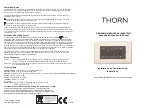
C H A P T E R
12
Configuring VTP V3
This chapter contains the following sections:
•
Configuring VTP V3
From Cisco NX-OS Release 7.2(0)N1(1), VLAN Trunk Protocol (VTP) V3 supports PVLAN integration, 4K
VLAN integration, generic database transport mechanism, and VTP authentication mechanism.
VTP V3 Overview
VTP V3 allows each router or LAN device to transmit advertisements in frames on its trunk ports. These
frames are sent to a multicast address where they can be received by all neighboring devices. They are not
forwarded by normal bridging procedures. An advertisement lists the sending device's VTP management
domain, its configuration revision number, the VLANs which it knows about, and certain parameters for each
known VLAN. By hearing these advertisements, all devices in the same management domain learn about any
new VLANs that are configured in the transmitting device. This process allows you to create and configure
a new VLAN only on one device in the management domain, and then that information is automatically
learned by all the other devices in the same management domain.
Once a device learns about a VLAN, the device receives all frames on that VLAN from any trunk port by
default, and if appropriate, forwards them to each of its other trunk ports, if any. This process prevents
unnecessary VLAN traffic from being sent to a device. An extension of VTP called VTP pruning has been
defined to limit the scope of broadcast traffic and save bandwidth. Beginning with Release 5.1(1), the Cisco
NX-OS software supports VTP pruning.
VTP also publishes information about the domain and the mode in a shared local database that can be read
by other processes such as Cisco Discovery Protocol (CDP).
Guidelines and Limitation
VTP Version 3 (VTPv3) was introduced in Cisco NX-OS release 7.2(0) and has the following features:
•
Provides interoperability with switches configured with VTP version 1 or 2.
Cisco Nexus 6000 Series NX-OS Layer 2 Switching Configuration Guide, Release 7.x
133
















































